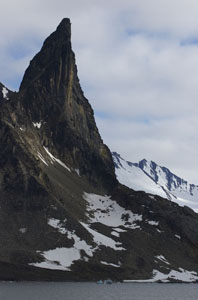Hornsund's geology and landscape
By Jørn Henriksen, Winfried Dallmann
 View towards Burgerbukta from Adriabukta. The ridge in the left part of the picture is Sofiekammen. In the middle is Luciakammen, dividing the bay of Burgerbukta into a western and eastern part. Hyrneodden can be seen to the right. (Image: Jørn Henriksen)
 The rusty and red-coloured stains in an outcrop along Sofiekammen suggests that the bedrock contain iron oxides. (Image: Jørn Henriksen) The rusty and red-coloured stains in an outcrop along Sofiekammen suggests that the bedrock contain iron oxides. (Image: Jørn Henriksen)
 Bautaen (487 m.a.s.l.) in Hornsund looks impressive from the right angle. (Image: Jørn Henriksen) Bautaen (487 m.a.s.l.) in Hornsund looks impressive from the right angle. (Image: Jørn Henriksen)
Landscape and geology
Hornsund has a similar fjord structure as the rest of western Spitsbergen, but is not as long as Isfjorden and Bellsund. The Hornsund area displays large variations in landscape and geology over short distances. The mountains, the valleys and the fjords combine to create huge local weather variations in the Hornsund area. There can, for example, be a strong easterly wind in Hornsund while along the west coast of Spitsbergen it is dead calm.
The western part of Hornsund is dominated by old bedrock. The carbonate rocks in Hornsund were deposited 500 million years ago. Characteristic of the areas north and south of Hornsund (on the west coast) – from Sørkapp to Isfjorden – are the large, wide strand flats. Though this makes the west coast appear more welcoming than the east coast, only a few places are actually easily accessible. Off the western coast are plenty of sunken rocks and shallow areas that make sailing near shore quite a challenge, and skerries and shoals generally make landings difficult, in addition to the constant swells coming in from the Greenland and Norwegian seas.
About half way into the fjord of Hornsund, a mighty alpine landscape arises – the peak of Hornsundtind in the south and the ridge Sofiekammen and Gnålberget to the north. Further in the fjord the landscape becomes less dramatic, with rounded and lower mountains. During the last ice age Hornsund was filled with ice. Burgerbukta and Samarinvågen were outlets for subsidiary glaciers and contributed to the outlet for the enormous masses of ice that covered the whole of Svalbard at that time (approximately 13,000 years ago). Hornsund is a very good example of how glaciers form the landscape and how the landforms depend on the composition and the structural framework of the bedrock.
The geology in Hornsund is very complex and enthusiasts tend to travel with a geological map at hand. Hornsundtind consists of bedrock of Ordovician age, i.e, 500 million years old. Sofiekammen and Gnålbergent are made up of carbonate rocks from the same period. At Treskelen the carbonate rocks has a characteristic yellowish weathering colour. The sandstone and conglomerates at Treskelen contain marine fossils which indicate that the rocks are of early Permian age, i.e. 275 million years old. All the rock types at Treskelen were folded and tilted, and pushed eastward during the formation of a mountain belt in the early Tertiary, about 40 to 55 million years ago. In Brepollen we find one of the most impressive glacial bays in Svalbard. In the past, Storbreen, Hornbreen and Chomjakovbreen formed a continuous glacier front surrounding the bay. This is documented in topographical maps from 1936. Today the glaciers have separate fronts; nevertheless they still appear impressive in size. Mendeléjevbreen and Svalisbreen, which used to be subsidiary glaciers to Hornbreen, now have their own glacier fronts. West of Bautaen, the 487 m high monolith-like peak, Chomjakovbreen is so reduced in size it has formed a bay, Svovelbukta, where the glacier front used to be. To the east of Brepollen the landscape flattens and is characterized by gentler slopes, in stark contrast to the jagged ridges in the west. The rounded mountains here mainly consist of horizontal sedimentary beds of sandstone and slate which are 100 to 130 million years old.
|